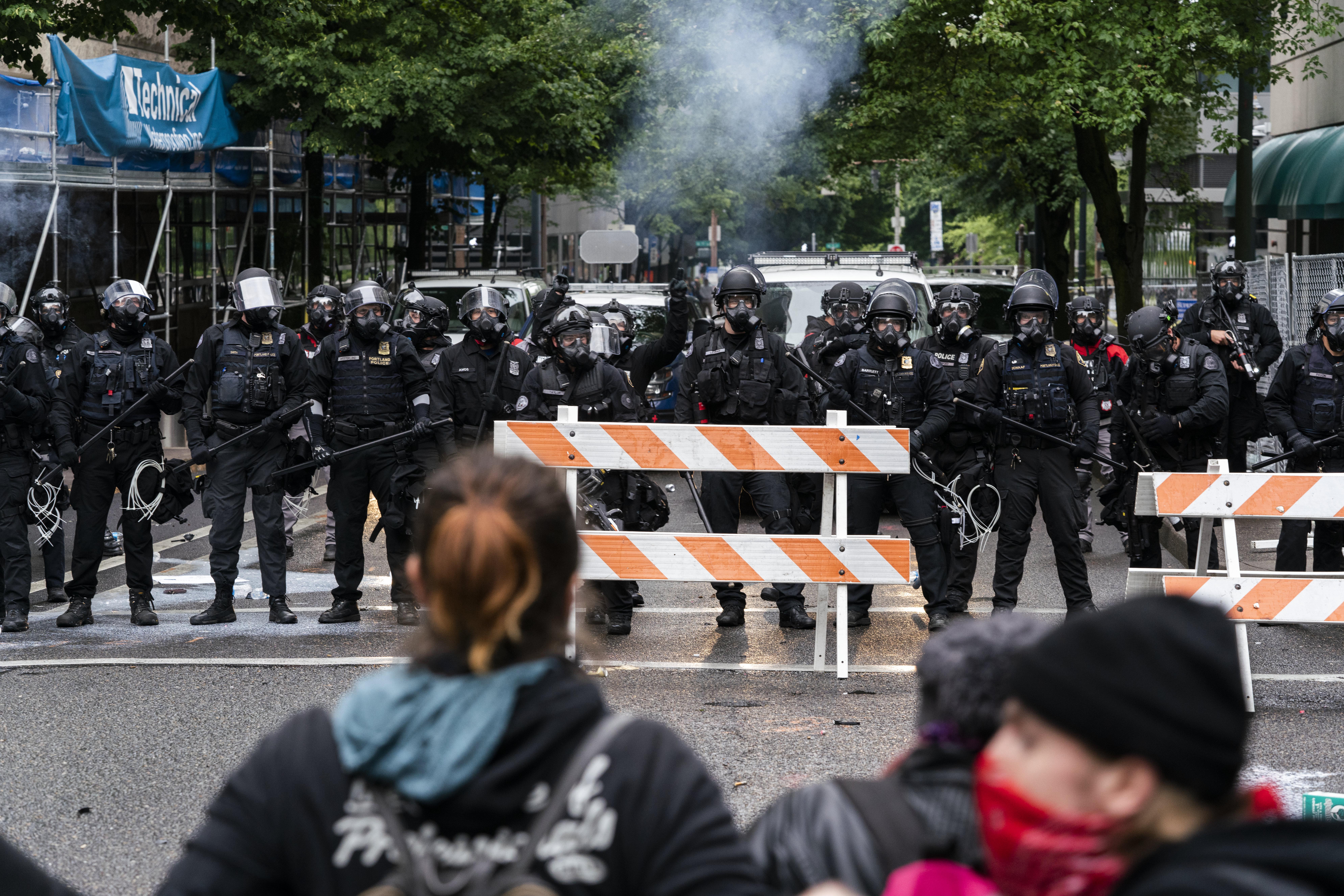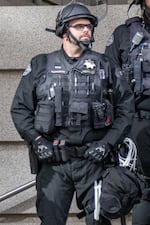
FILE - Portland police line up before protesters near the Multnomah County Justice Center in Portland, Ore., May 30, 2020. City leaders in Portland are reviving a protest response team, though some residents are skeptical and say their confidence was eroded by the police response to 2020 racial justice protests in the city.
Jonathan Levinson / OPB
Days after the Portland Police Bureau officially relaunched its crowd-control unit, questions remain about how much it has changed from its headline-grabbing predecessor.
Some police reform advocates and members of police oversight groups said this week that they’re still unclear how the city’s new Rapid Response Team — often used to break up protests — will differ from its past iteration.
“I think what we want to understand is how this will be different,” said Kip Silverman, a member of the Portland Committee on Community-Engaged Policing. The team aids Mayor Ted Wheeler’s office in overseeing the bureau.
“Personally,” Silverman added, “I don’t feel OK that there’s not a lot of detail.”
Bureau officials revealed at a recent press conference that the team has officially returned to training after a three-year hiatus. The RRT infamously disbanded after its officers resigned in protest that one member was charged with fourth-degree assault. The charge was later dropped.
Portland Police Chief Bob Day said the city may need the team this year. He and other officials worry this year’s U.S. presidential election could spark a return to heated, nightly protests.

A press conference sharing information about Portland Police Bureau’s Rapid Response Team, at the Justice Center in Portland, Ore., on June 13, 2024. The revamped team consists of 50 members, and will return to duty this year, after being disbanded in 2021.
Troy Brynelson / OPB
The team recently completed its first full week of training, Portland police spokesperson Sgt. Kevin Allen said. Police brass stressed in the June 13 press conference that the unit will have a new approach and updated training to improve how the city handles the boots-on-the-ground job of policing demonstrations.
“Our expectations are high,” said Wheeler, who oversees the bureau as the city’s police commissioner. “We expect our officers to embody their training and engage with the community with integrity as well as with resolve.”
At the press conference, bureau officials showcased new uniforms and some equipment, such as bicycle helmets and transparent shields. On a folding table, impact munitions rested near a body-worn camera, which officers will soon begin wearing.
Police officials said the revamped team will train an additional 96 hours annually. The bureau will also use training standards set by an organization called the National Tactical Officers Association.
Related: Portland will reinstate protest response team ahead of 2024 elections
Mostly, officials at the press conference spoke with optimism. Cmdr. Craig Dobson likened the unit to a “symphony” where units within the team work together.
“Publicly, when you sit in the stands and you watch an event, you see the actual members of a symphony,” Dobson said. “But behind the scenes, that the public never sees, is a whole team that makes that symphony successful.”
Much of that teamwork is the same, or will at least look very similar, to the past team, bureau officials acknowledged to OPB. An officer who acts as a liaison, for example, will make first contact with demonstrators.
“Their role is not to do enforcement,” said Cmdr. Franz Schoening of the liaison officers. “They’re there to facilitate communication.”
The other pieces are hands-on. Bike cops may intervene at first, followed by armored crowd-control officers “if criminal activity is happening unabated,” Schoening said.
Disband and return
The Rapid Response Team has remained a flashpoint between those who advocate for police reform and those who say the city needs a stronger police presence.
In Portland, protesters took to the streets each night for months after George Floyd’s killing by Minneapolis police officers. Peaceful protests devolved into clashes between demonstrators and police, including the Rapid Response Team. Police deployed impact munitions, tear gas, pepper spray and other tools designed for crowd control.

FILE: In this 2020 photo supplied by a protest observer, Portland Police Bureau Officer Corey Budworth is suited up in front of the Multnomah County Justice Center. Budworth was indicted with one count of fourth-degree assault for physically injuring someone during a protest, a charge that was later dropped.
Courtesy of Doug Brown
In September 2021, the Multnomah County District Attorney’s office brought a fourth-degree assault charge against Officer Corey Budworth for striking a photographer in the head with a baton during a 2020 protest. The entire Rapid Response Team resigned in protest. The criminal charge was later dropped.
A city-funded audit by consultant Independent Monitor LLC later found the team relied too heavily on its crowd-control munitions and alienated many Portlanders.
In the years since, the city has approved at least $2.5 million in settlements to help pay for protesters’ injuries, according to the group Portland Copwatch.
In its audit, Independent Monitor LLC recommended the city eventually reform its crowd-control team. The consultant made 11 other recommendations, including for the group to “dramatically reduce its reliance” on crowd-control munitions and ensure the team has a transparent public re-introduction. The new team is prepared to use crowd-control munitions again, said Schoening, but he expects there will be a “significant decrease” in officers using them.
Related: Oregon lawmakers OK police accountability measures, but face calls for bigger change
City officials recently began laying the groundwork to return to the team. City commissioners in March approved a 6% raise for officers selected for the team — amounting to $380,000 total. City commissioners also approved a $1.1 million purchase for training and new equipment.
The new team is entirely volunteer, according to Portland Police Chief Day, with 50 officers joining.
Most of those officers worked previously on the RRT. According to Day, 35 officers who participated in the mass resignation are returning to the squad. Eight of the 50 officers are sergeants.
When asked by a reporter if the city can prevent another wave of resignations, Day said no.
“The reality is that this is a volunteer assignment,” he said. “But my belief and my hope is that this time around as an organization we will do a better job supporting them in the challenge that we’re asking them to take on.”

Equipment to be used by Portland Police Bureau’s Rapid Response Team is displayed during a press conference held June 13, 2024, at the Justice Center in Portland, Ore. The revamped team consists of 50 members and will return to duty this year after being disbanded in 2021.
Troy Brynelson / OPB
A work in progress
To some, the rollout has raised as many questions as it purports to answer.
A recent meeting between Day, a city attorney and the Portland Committee on Community-Engaged Policing left some committee members frustrated that they couldn’t learn more about how the protest squad is being trained or the names of officers picked to serve.
Some former Rapid Response Team members applied to return to the new team but bureau officials vetoed them due to “internal affairs histories,” Day told the committee, while declining to offer specifics.
“Chief Day was kind enough to come talk to us and share his understanding of how things are coming together,” Silverman, the committee member, said. “There were some generalities and intentions, but not enough detail for us to feel like we really understood what would be different.”
Related: Portland and other cities ask Oregon lawmakers to change restrictions on protest response
Silverman said he wanted to hear more about new training and policies that will dictate how the team behaves. The team’s training materials have not been made public. And police response to last month’s pro-Palestinian demonstrations that took over Portland State University’s library for multiple days suggested to Silverman that the bureau has a ways to go.
Silverman referenced video captured at the school showing police officers, including PSU campus security officers, shoving people outside a parking garage. Two PSU students have signaled they intend to sue.
“All of this coming together — where we keep hearing a narrative out of the police bureau that they’re getting ready because it’s going to be a tough year — is very concerning,” Silverman said.
Some Oregon laws have changed in the intervening years since the Rapid Response Team disbanded. Lawmakers have changed how and when police can declare a riot, and have restricted the use of tear gas, impact munitions and pepper spray as crowd-control tools.
Related: Portland Police Describe Nightly Face-offs With Protesters As Unsustainable
Juan Chavez, an attorney who represented the photographer struck by Budworth, worried those law changes won’t provide enough protection for the public. He accused the bureau of training its officers to use excessive force, a claim bureau spokespeople deny.
“It’s no solace to me and people in the streets that state laws have changed,” Chavez said. “When they will still — I think — train their officers to use excessive force.”
Stephanie Howard, who oversees public safety for Wheeler, acknowledged to OPB that there are still many questions about the team. It’s going to be a long process, she said.
“If I’m putting on my citizen hat, I’m glad to know about this before all the answers are developed and be provided an opportunity to weigh in,” Howard said.



